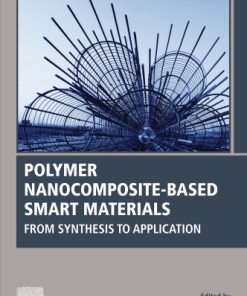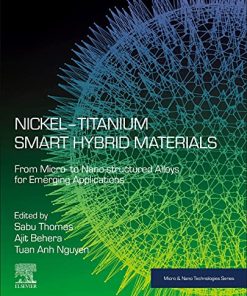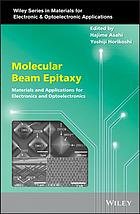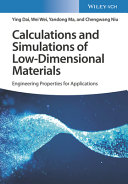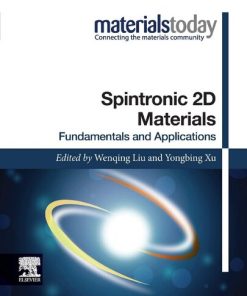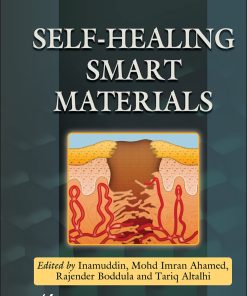(Ebook PDF) Ferroic materials for smart systems from fundamentals to device applications 1st edition by Jiyan Dai 3527344764 978-3527344765 full chapters
$50.00 Original price was: $50.00.$25.00Current price is: $25.00.
Ferroic materials for smart systems from fundamentals to device applications 1st edition by Jiyan Dai – Ebook PDF Instant Download/DeliveryISBN: 3527344764, 978-3527344765
Full dowload Ferroic materials for smart systems from fundamentals to device applications 1st edition after payment.
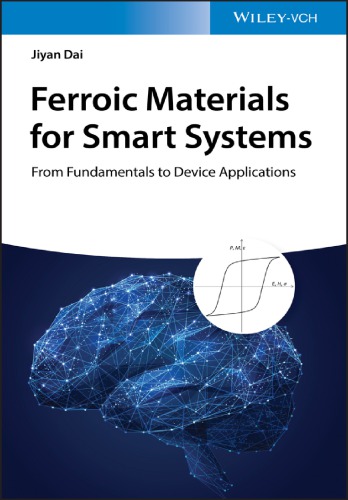
Product details:
ISBN-10 : 3527344764
ISBN-13 : 978-3527344765
Author: Jiyan Dai
This book covers the fundamental physics, fabrication methods, and applications of ferroic materials and covers bulk, thin films, and nanomaterials. It provides a thorough overview of smart materials and systems involving the interplays among the mechanical strain, electrical polarization, magnetization, as well as heat and light. Materials presented include ferroelectric, multiferroic, piezoelectric, electrostrictive, magnetostrictive, and shape memory materials as well as their composites. The book also introduces various sensor and transducer applications, such as ultrasonic transducers, surface acoustic wave devices, microwave devices, magneto-electric devices, infrared detectors and memories.
Ferroic materials for smart systems from fundamentals to device applications 1st Table of contents:
1 General Introduction: Smart Materials, Sensors, and Actuators 1
1.1 Smart System 2
1.2 Device Application of Ferroelectric Materials 5
1.2.1 Piezoelectric Device Applications 6
1.2.2 Infrared Sensor 7
1.2.3 Ferroelectric RAM (FeRAM) 8
1.3 Device Application of Ferromagnetic Materials 9
1.3.1 Spin-Transfer Torque Memory 9
1.3.2 Magnetic Field Sensor Based on Multiferroic Device 9
1.4 Ferroelastic Material and Device Application 10
1.5 Scope of This Book 12
References 13
2 Introduction to Ferroelectrics 15
2.1 What is Ferroelectrics? 15
2.1.1 P–E Loop 15
2.1.2 Relationships Between Dielectric, Piezoelectric, Pyroelectric, and Ferroelectric 16
2.1.2.1 Ferroelectric–Dielectric 16
2.1.2.2 Ferroelectric–Piezoelectric 17
2.1.2.3 Ferroelectric–Pyroelectric 18
2.2 Origin of Ferroelectrics 18
2.2.1 Structure-Induced Phase Change from Paraelectric to Ferroelectric 18
2.2.2 Soft Phonon Mode 19
2.3 Theory of Ferroelectric Phase Transition 21
2.3.1 Landau Free Energy and Curie–Weiss Law 21
2.3.2 Landau Theory of First-Order Phase Transition 23
2.3.3 Landau Theory of a Second-Order Phase Transition 26
2.4 Ferroelectric Domains and Domain Switching 28
2.4.1 Domain Structure 28
2.4.2 Ferroelectric Switching 28
2.5 Ferroelectric Materials 29
2.5.1 From BaTiO3 to SrTiO3 29
2.5.2 From PbTiO3 to PbZrO3 32
2.5.3 Antiferroelectric PbZrO3 33
2.5.3.1 Pb(Zrx Ti1−x)O3 (PZT) 35
2.5.4 Relaxor Ferroelectrics 36
2.5.4.1 Relaxor Ferroelectrics: PMN-xPT Single Crystal 37
2.5.4.2 Polar Nano Regions 38
2.5.4.3 Morphotropic Phase Boundary (MPB) of PMN-PT Crystal 40
2.6 Ferroelectric Domain and Phase Field Calculation 41
References 42
3 Device Applications of Ferroelectrics 47
3.1 Ferroelectric Random-Access Memory 47
3.2 Ferroelectric Tunneling Non-volatile Memory 50
3.2.1 Tunneling Models 51
3.2.2 Metal–Ferroelectric–Semiconductor Tunnel Junction 55
3.2.3 Ferroelectric Tunneling Memristor 56
3.2.4 Strain Modulation to Ferroelectric Memory 57
3.3 Pyroelectric Effect and Infrared Sensor Application 58
3.3.1 Pyroelectric Coefficient 58
3.3.2 Pyroelectric Infrared Sensor 59
3.3.3 Pyroelectric Figures of Merit 60
3.4 Application in Microwave Device 63
3.5 Ferroelectric Photovoltaics 65
3.6 Electrocaloric Effect 67
References 68
4 Ferroelectric Characterizations 73
4.1 P–E Loop Measurement 73
4.2 Temperature-Dependent Dielectric Permittivity Measurement 76
4.3 Piezoresponse Force Microscopy (PFM) 77
4.3.1 Imaging Mechanism of PFM 77
4.3.2 Out-of-plane Polarization (OPP) and In-plane Polarization (IPP) PFM 80
4.3.2.1 Electrostatic Force in PFM 83
4.3.2.2 Perspectives of PFM Technique 84
4.4 Structural Characterization 86
4.5 Domain Imaging and Polarization Mapping by Transmission Electron Microscopy 87
4.5.1 Selected Area Electron Diffraction (SAED) 88
4.5.2 Convergent Beam Electron Diffraction (CBED) for Tetragonality Measurement 91
References 92
5 Recent Advances in Ferroelectric Research 95
5.1 Size Limit of Ferroelectricity 95
5.2 Ferroelectricity in Emerging 2D Materials 96
5.3 Ferroelectric Vortex 99
5.4 Molecular Ferroelectrics 104
5.5 Ferroelectricity in HfO2 and ZrO2 Fluorite Oxide Thin Films 106
5.6 Ferroic Properties in Hybrid Perovskites 114
References 117
6 Piezoelectric Effect: Basic Theory 123
6.1 General Introduction to Piezoelectric Effect 123
6.2 Piezoelectric Constant Measurement 124
6.2.1 Piezoelectric Charge Constant 125
6.2.2 Piezoelectric Voltage Constant 126
6.2.3 Dielectric Permittivity 127
6.2.4 Young’s Modulus (Elastic Stiffness) 127
6.2.5 Elastic Compliance 127
6.2.6 Electromechanical Coupling Factor 128
6.2.6.1 How to Measure Electromechanical Coupling Factor? 129
6.3 Equivalent Circuit 132
6.4 Characterization of Piezoelectric Resonator Based on a Resonance Technique 135
6.4.1 Length Extensional Mode of a Rod 135
6.4.2 Extensional Vibration Mode of a Long Plate 138
6.4.3 Thickness Shear Mode of a Thin Plate 139
6.4.4 Thickness Mode of a Thin Disc/Plate 140
6.4.5 Radial Mode in a Thin Disc 141
6.4.6 Mechanical Quality Factor 141
References 141
7 Piezoelectric Devices 143
7.1 Piezoelectric Ultrasonic Transducers 143
7.1.1 Structure of Ultrasonic Transducers 143
7.1.2 Theoretical Models of Ultrasonic Transducer (KLM Model) 145
7.1.3 Characterization of Ultrasonic Transducers 147
7.1.3.1 Bandwidth (BW) 147
7.1.3.2 Sensitivity of the Transducer 148
7.1.3.3 Resolution 148
7.1.4 Types of Ultrasonic Transducers 149
7.1.4.1 Medical Application 149
7.1.5 Piezoelectric Film Application in Ultrasound Transducers 149
7.1.6 Challenges and Trend of Developing New Advanced Ultrasound Transducers 150
7.2 Ultrasonic Motor 150
7.2.1 Terminologies 151
7.2.2 Design of USM 153
7.3 Surface Acoustics Wave Devices 154
7.3.1 Interdigital Electrode in SAW Device 155
7.3.2 Acoustic Wave 155
7.3.3 Piezoelectric Property Considerations for SAW Devices 157
7.3.4 Characterization of SAW Devices 159
7.3.5 Lead-Free Piezoelectric Materials 161
References 163
8 Ferromagnetics: From Material to Device 165
8.1 General Introduction to Ferromagnetics 165
8.2 Ferromagnetic Phase Transition: Landau Free-Energy Theory 168
8.3 Domain and Domain Wall 169
8.4 Magnetoresistance Effect and Device 171
8.4.1 Anisotropic Magnetoresistance (AMR) 171
8.4.2 Giant Magnetoresistance (GMR) 172
8.4.3 Colossal Magnetoresistance (CMR) 175
8.4.4 Tunneling Magnetoresistance (TMR) 176
8.4.4.1 Spin-Transfer Torque Random-Access Memory (STT-RAM) 177
8.5 Magnetostrictive Effect and Device Applications 178
8.5.1 Magnetostrictive Properties of Terfenol-D 180
8.5.2 Magnetostrictive Ultrasonic Transducer 183
8.5.3 Magnetoelastic Effect 184
8.5.3.1 Magnetomechanical Strain Gauge 185
8.6 Characterizations of Ferromagnetism 186
8.6.1 Vibrating Sample Magnetometer (VSM) 186
8.6.2 Superconducting Quantum Interference Device (SQUID) 187
8.6.3 Magnetic Force Microscopy (MFM) 188
8.6.4 Magneto-Optical Kerr Effect (MOKE) 189
8.7 Hall Effect 191
8.7.1 Ordinary Hall Effect 191
8.7.2 Anomalous Hall Effect 191
8.7.3 Spin Hall Effect 192
References 193
9 Multiferroics: Single Phase and Composites 197
9.1 Introduction on Multiferroic 197
9.2 Magnetoelectric Effect 199
9.3 Why are There so Few Magnetic Ferroelectrics? 199
9.4 Single Phase Multiferroic Materials 200
9.4.1 Switching Mechanism in BFO Films 204
9.5 ME Composite Materials 205
9.6 Modeling the Interfacial Coupling in Multilayered ME Thin Film 207
9.6.1 PZT/CFO Multilayered Heterostructures 207
9.6.2 Ferroelectric Properties of PZT/CFO Multilayers 209
References 212
10 Device Application of Multiferroics 217
10.1 ME Composite Devices 217
10.1.1 Effect of Preload Stress 221
10.2 Memory Devices Based on Multiferroic Thin Films 223
10.3 Memory Devices Based on Multiferroic Tunneling 224
References 229
11 Ferroelasticity and Shape Memory Alloy 231
11.1 Shape Memory Alloy 231
11.1.1 SMA Phase Change Mechanism 232
11.1.2 Nonlinearity in SMA 233
11.1.3 One-Way and Two-Way Shape Memory Effect 235
11.1.4 Superelastic Effect (SE) 235
11.1.5 Application Examples of SMAs 236
11.2 Ferromagnetic Shape Memory Alloys 237
11.2.1 Formation of Twin Variants 238
11.2.2 Challenges for Ni–Mn–Ga SMA 242
11.2.3 Device Application of MSMA 243
People also search for Ferroic materials for smart systems from fundamentals to device applications 1st:
smart materials for microrobots
ferroic materials
ferro-tic material
ferrous systems github
smart materials mfc
You may also like…
Engineering - Industrial Engineering & Materials Science
Engineering - Mechanical Engineering & Dynamics
Engineering
Uncategorized




